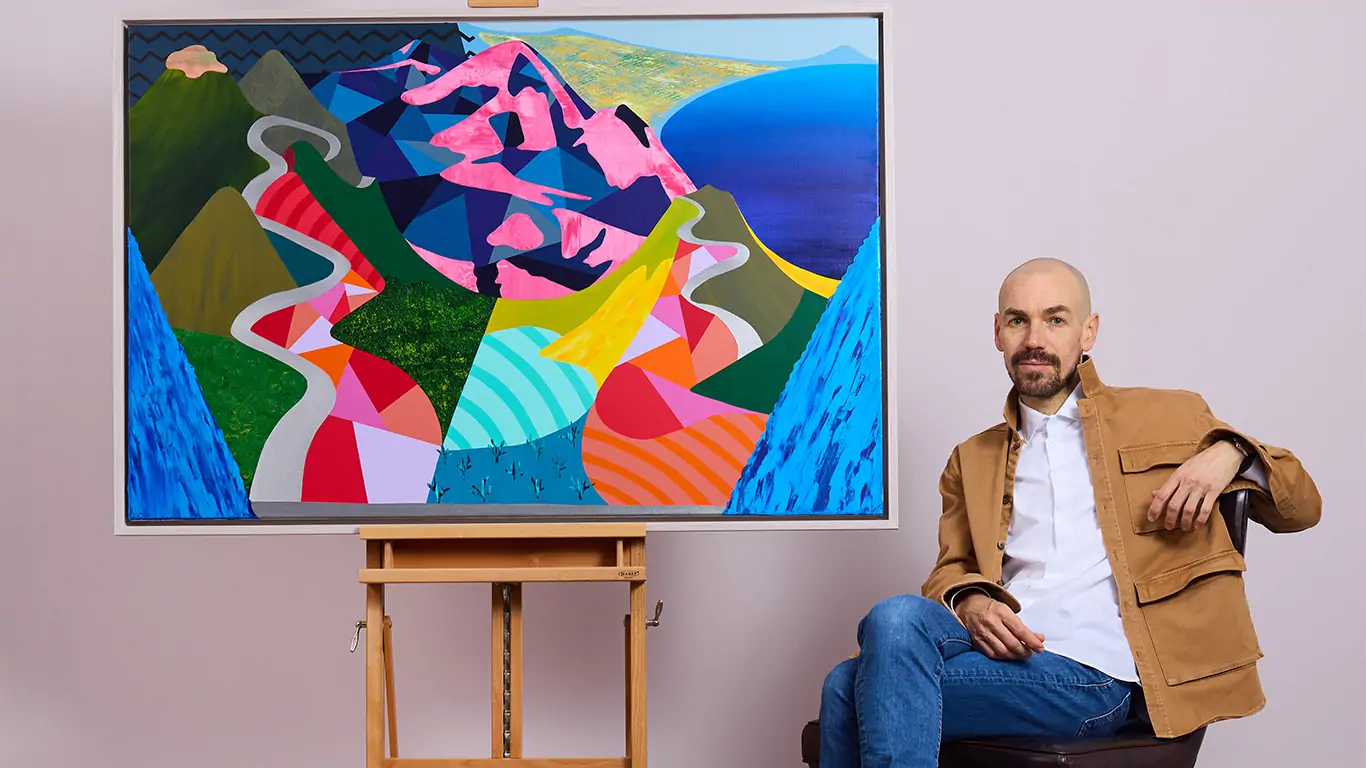Spanish artist Pedro Paricio continues a rich legacy of appropriation and reinvention that has swung back and forth throughout the history of painting—this creative pendulum, swinging between traditional and contemporary influences, fuels his expressive vernacular.
Walking the tightrope between figurative, abstract, and landscape, Paricio‘s practice questions the artist’s role and themes of identity and self-representation by blending street and pop art with fine art, all while honouring the great masters of the past, such as Picasso, Magritte, Vermeer, Warhol and Hockney, through his stylistic nods and thematic explorations.
Cultivating a signature style, Paricio adapts familiar silhouettes with prismatic colours and intricate geometric patterns that instantly catch the eye. Throughout his work, he marries the liveliness of street and pop art with classical fragments of art history.
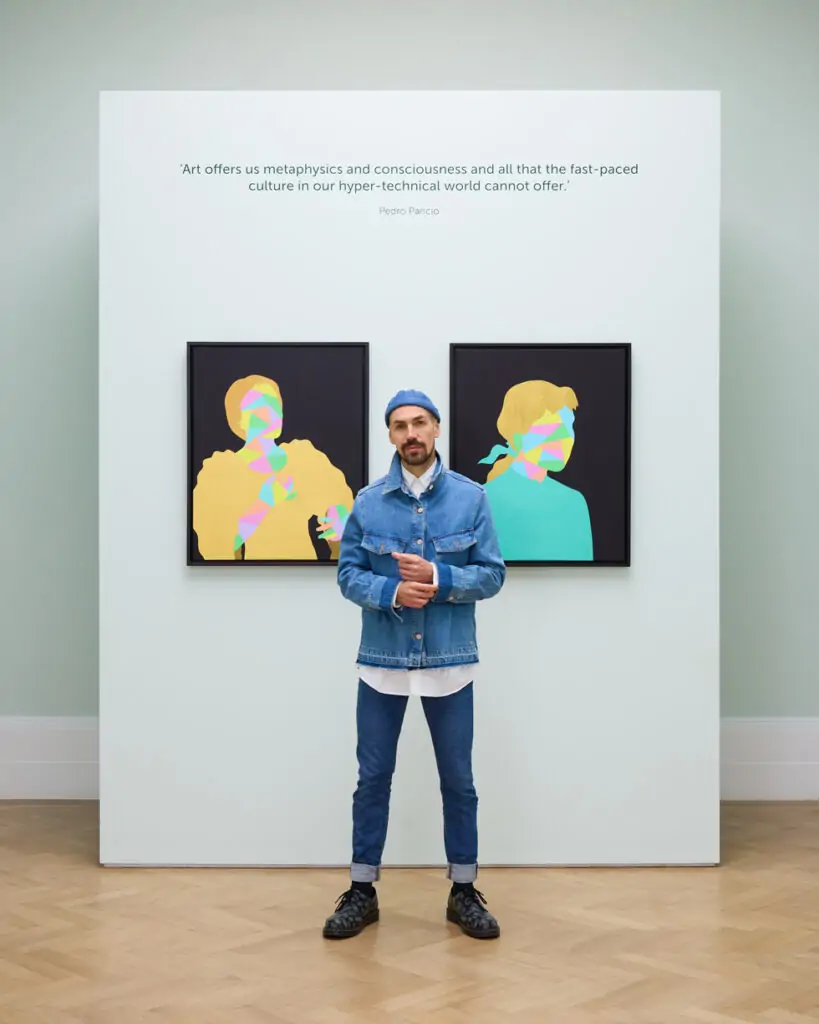
Image courtesy of the artist and Halcyon Gallery
I want my art to be open to interpretation. Whilst at times it can appear as mysterious, it is a mystery that I hope everyone can fit into and take part in
Pedro Paricio
Paricio often constructs alter-ego references, inserting himself into the compositions dressed in a black jacket, hat, and tie—a nod to painter René Magritte, whose works famously feature men in bowler hats. By deconstructing his subjects’ identities and replacing facial characteristics with patterns or geometric shapes of colour, he invites contemplation through ambiguity. In Paricio’s “Bull from Guernica” (2018), we see the artist take on his fellow countryman and iconic artist, Pablo Picasso.
Picasso’s powerful rendition of “Guernica” captures the heart-wrenching realities of war and the suffering experienced by innocent lives. Through a haunting palette of black, white, and blue-scale accents, the work evokes raw emotion and empathetically reflects the starkness and muted agony of these tragic events.
Paricio takes the bull from Picasso’s puzzle and reimagines this classic symbol with a striking juxtaposition full of colour. He presents a vision that is both fragmented and unified, blending surrealism and abstraction while still keeping the underlying essence of the bull’s form in its original offering.
In his landscape works, Pedro Paricio delivers a complex yet aesthetically pleasing visual experience. His use of bold, contrasting colours immediately captures attention, forming a patchwork of angular shapes where mountains, valleys, trees, and the sky interlock like puzzle pieces, creating a sense of depth and movement across his canvas. Once again, we see Paricio reworking the familiar with the fantastical, prompting reflection.
Through his lively renditions, Paricio has cultivated a highly recognisable style by juxtaposing street and pop art with underlying fragments of the masters. It’s clear that Paricio relishes colour and art history, inviting us to relish it too through his surreal and abstract lens of re-imagination. We managed to catch up with the artist during his exhibition at Halcyon Gallery‘s Songs of the Open Road until September 1st 2024.
Hi Pedro, thank you for speaking with us. Could you please introduce yourself to those who might not be familiar with your work?
Pedro Paricio: I am a contemporary artist originally from Tenerife in the Canary Islands and I am now based in Barcelona.
Could you take us on a journey through your early moments in the arts? What unique experiences and motivations led you to embark on a career as an artist?
Pedro Paricio: I became an artist the day I was born as I believe in destiny. I believe that until you find what your calling is you cannot be happy, and for me, since being a really young child I have always been happy and I think that is because I knew I was going to be an artist!
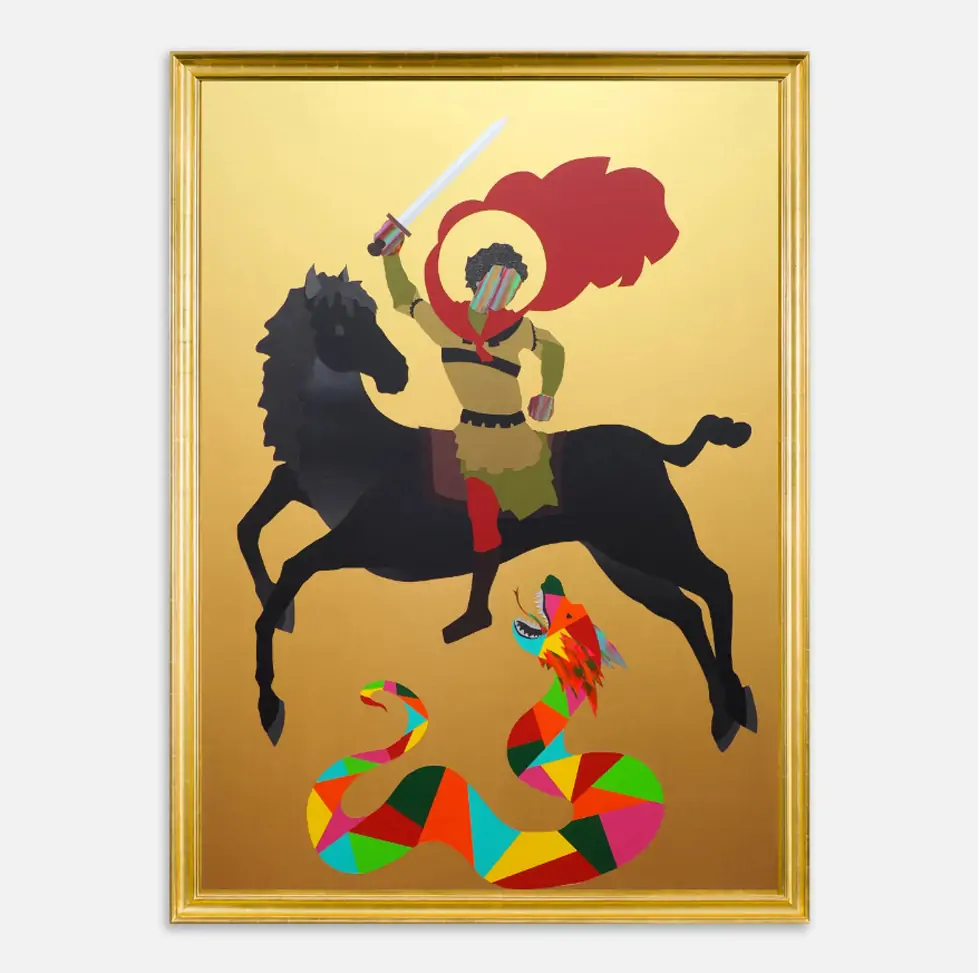
Acrylic on linen
114 x 81 cm
Image courtesy of the artist and Halcyon Gallery
Your practice is deeply rooted in contemporary science, Hispanic folklore, music, and philosophy. These diverse influences are masterfully woven into your work, creating a fusion of street culture and fine art. Can we delve into how these inspirations shape your practice and the themes in your work?
Pedro Paricio: I take inspiration from many places and people. Firstly the world around me; Tenerife is full of vibrant colours and incredible light, which makes my world full of colour. Of course my Spanish forebears, such as Picasso who I owe a great deal to, have also informed my work, as has Spanish culture – I live in Barcelona where it is impossible to deny the influence Gaudi has had on the city. But I also look to the past, to the 51,000 years of art history that have come before us, right back to the oldest cave paintings in Indonesia. In order to move forwards into the future I need to understand the past first. Museums are a great help for this.
Aside from art, I come from a family where literature was very important, so books are a huge influence, as is cinema and film and music – I am inspired by culture in all its forms really.
Drawing from diverse subjects, including music and philosophy, how do these disciplines inform your practice and the themes you explore in your paintings?
Pedro Paricio: Novels make me dream and philosophy makes me wake up… I love to read fiction at night after a long day in the studio. Music, especially opera, is a source of energy, as is every human creative act, every piece of art, of music, of writing. It is like a domino effect, each output of creativity inspiring the other, creating a chain of culture and tradition.

Acrylic on linen
92.5 x 97 cm
Image courtesy of the artist and Halcyon Gallery
In addition, your exploration of appropriation involves borrowing and adapting imagery from the past. How do you select the elements you wish to appropriate, and what is your process for integrating them into your visual language?
Pedro Paricio: I think it is impossible for painters to ignore the influence of the Masters that have preceded them. Rafael took from Michelangelo, Manet took from Giorgione, Picasso from Velazquez… but I don’t appropriate images, my art is about the soul and the joy of life, for me this is totally intuitive. My art touches classicism, pop, tradition and the past and the future all at the same time.
A recurring theme in your aesthetic is the use of blanked-out faces, prismatic colours, and geometric patterns, which serve as signature motifs. These introduce layers of meaning and play with the identity of the subject and artist. What message or commentary are you conveying through these recurring elements, and how do they contribute to the narrative and emotional impact of your pieces?
Pedro Paricio: I want my art to be open to interpretation. Whilst at times it can appear as mysterious, it is a mystery that I hope everyone can fit into and take part in. Every painting is complete just for a moment, then when a person views it, looks at it and feels it, they make the artwork their own, giving it their own story. My idea of identity relies on this triangle between me, the painting and the person who views it.
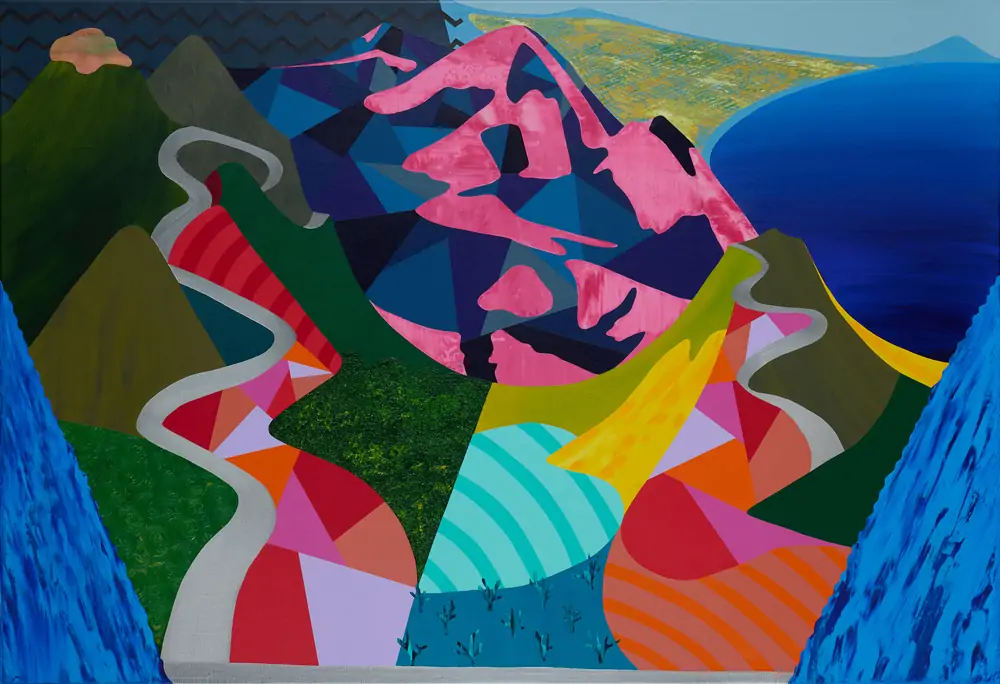
Acrylic on Linen
89 x 130 cm
Image courtesy of the artist and Halcyon Gallery
With your interest in both historical masterpieces and modern influences, how do you navigate the tension between preserving traditional techniques and embracing contemporary trends in your work?
Pedro Paricio: Human memory is so important to my work, as memory is inside the tradition of painting. Artists are constantly pressured to add something new to the canon that has come before us, but I don’t think you can always completely invent something new. It is more about taking what has come before us and building upon it. It’s evolution rather than invention, and this is what is evident in my work.

Acrylic on linen
85.5 x 80cm
Image courtesy of the artist and Halcyon Gallery
You mentioned that “a work of art is not only today, it is simultaneously yesterday and tomorrow.” Can you share with us how you convey this concept of time within a single piece of art?
Pedro Paricio: Art is a time machine, it is the unique thing that travels through time and survives for centuries. When we look at a Greek sculpture we are connecting instantaneously with a human soul from 2,500 years ago. When we really look at a Titian we are observing Venetian life from 500 years ago. But to feel these things you have to really look. Not the type of looking that is seeing and taking a photo and quickly moving on to the next thing. To look is when you arrive at an understanding with the piece, in the same way that when you are listening to music, you close your eyes and you are taken away to another place. That is to look at a piece of art, to give yourself to it.
Looking ahead, what new conceptual problems or cultural elements are you interested in exploring, and are there any upcoming projects or themes you are particularly excited about?
Pedro Paricio: I always create artworks in series so every collection is formed like a story, a complete body of work with its own narrative. When I find a new inspiration I become completely absorbed by it, and at the moment I am really focussing on landscapes inspired by Hockney, one the last great living masters. I share his love for life, his love of colour, the way he recreates the world. He reinvents the way we see again and again, especially with his investigation of en plein air paintings created with his iPad.
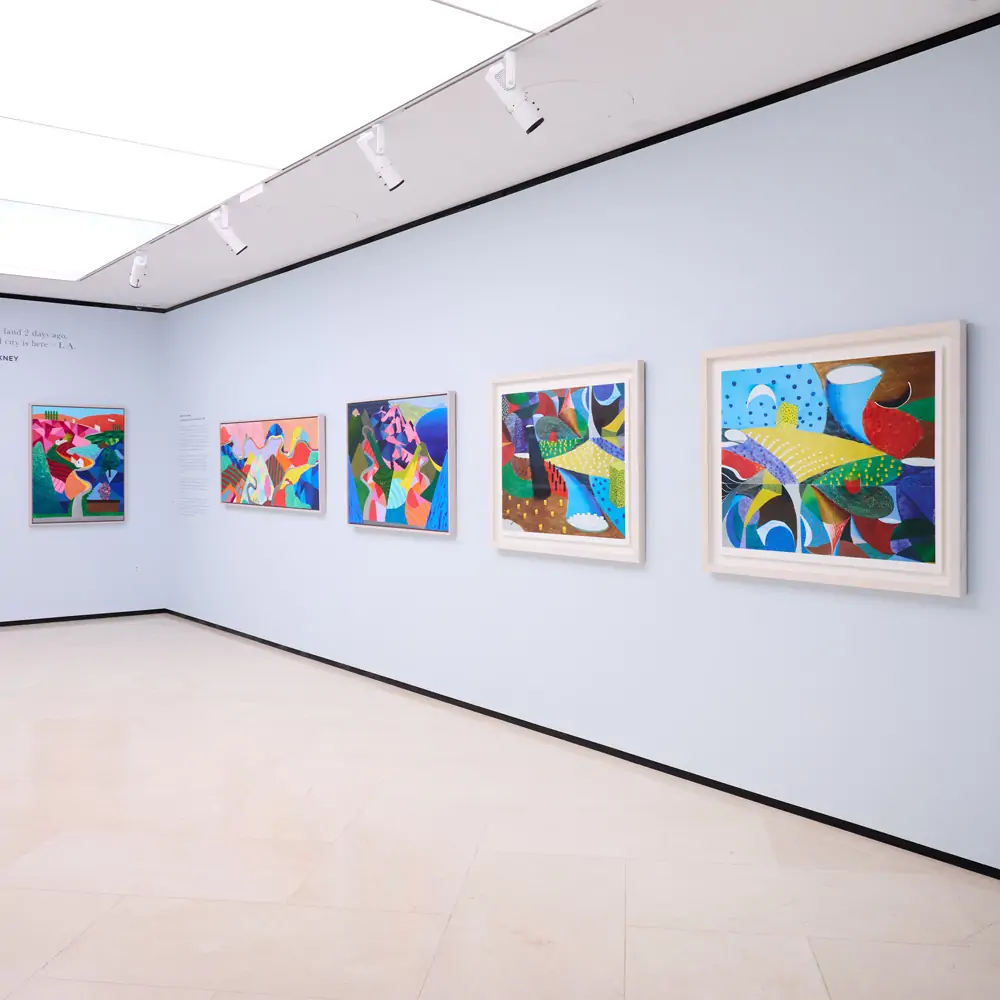
Image courtesy of the artist and Halcyon Gallery
Lastly, could you share your philosophy of art? How do you describe and understand the core importance of art in your life and career?
Pedro Paricio: Art is everything for me. 24 hours a day, 7 days a week, 365 days a year. Of course I love my family with all my heart and there are more things which interest me… but I relate all of them with art constantly… I see everything through the lens of art and it is always in my mind, in my heart and in my soul.
Discover Paricio’s new landscape paintings on view at Halcyon Gallery’s latest exhibition Songs of the Open Road, until September 1.
©2024 Pedro Paricio


